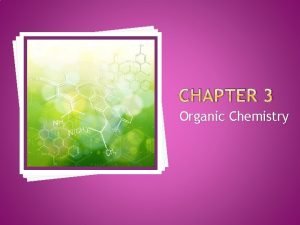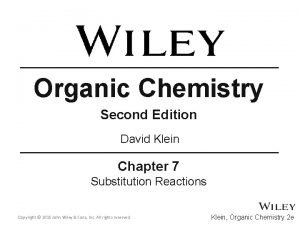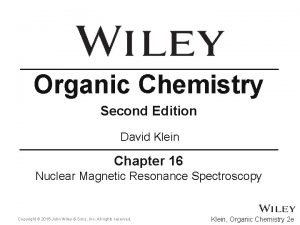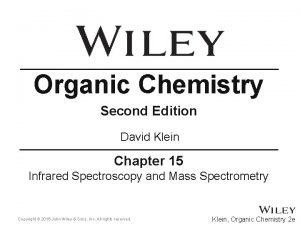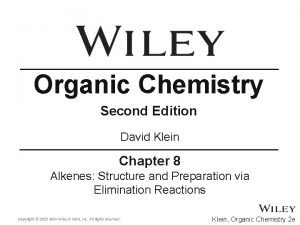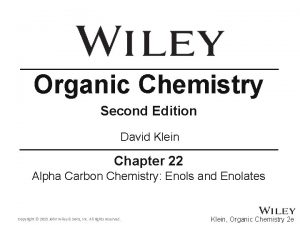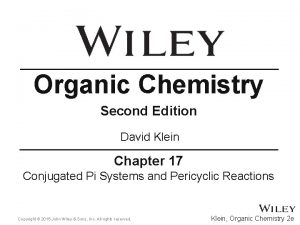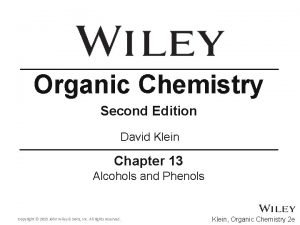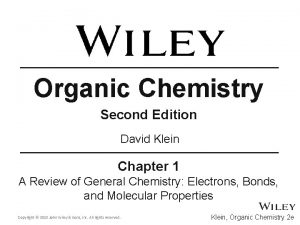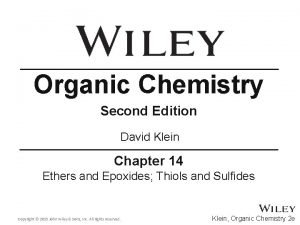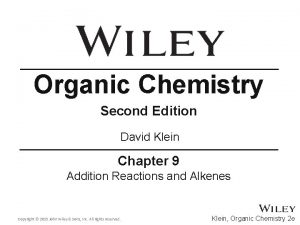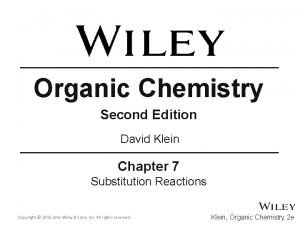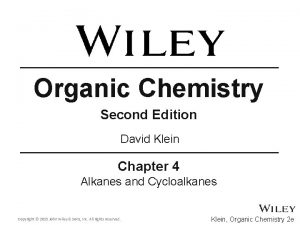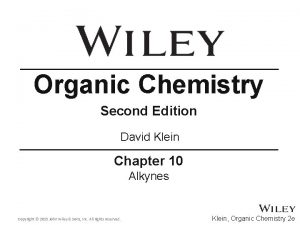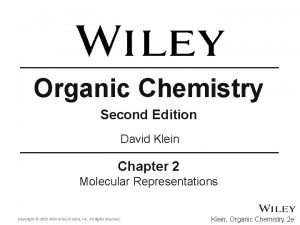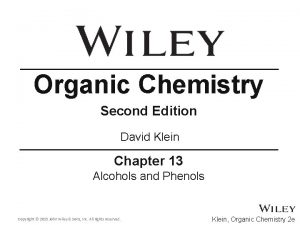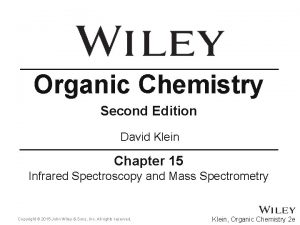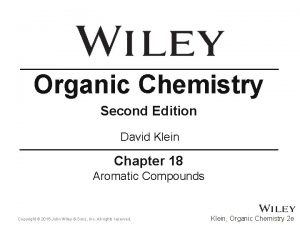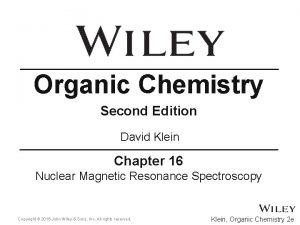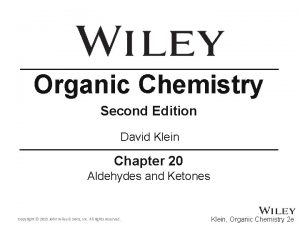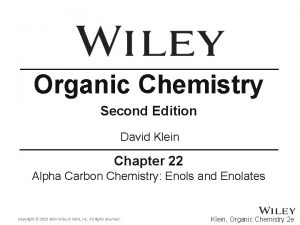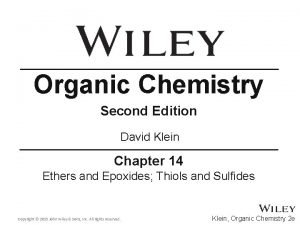Organic Chemistry Second Edition David Klein Chapter 11

































- Slides: 33

Organic Chemistry Second Edition David Klein Chapter 11 Radical Reactions Copyright © 2015 John Wiley & Sons, Inc. All rights reserved. Klein, Organic Chemistry 2 e

11. 1 Free Radicals • Free radicals form when bonds break homolytically • Note the single-barbed or fishhook arrow used to show the electron movement Copyright © 2015 John Wiley & Sons, Inc. All rights reserved. 11 -2 Klein, Organic Chemistry 2 e

11. 1 Free Radicals • Recall the orbital hybridization in carbocations and carbanions Copyright © 2015 John Wiley & Sons, Inc. All rights reserved. 11 -3 Klein, Organic Chemistry 2 e

11. 1 Free Radicals • Free radicals can be thought of as sp 2 hybridized or quickly interconverting sp 3 hybridized sp 2 hybridized Copyright © 2015 John Wiley & Sons, Inc. All rights reserved. 11 -4 Klein, Organic Chemistry 2 e

11. 1 Free Radical Stability • Free radicals do not have a formal charge but are unstable because of an incomplete octet • Groups that can push (donate) electrons toward the free radical will help to stabilize it. WHY? HOW? Consider hyperconjugation Copyright © 2015 John Wiley & Sons, Inc. All rights reserved. 11 -5 Klein, Organic Chemistry 2 e

11. 1 Free Radical Resonance • Drawing resonance for free radicals using fishhook arrows to show electron movement • Remember, for resonance, the arrows don’t ACTUALLY show electron movement. WHY? • Draw the resonance hybrid for an allyl radical • HOW and WHY does resonance affect the stability of the free radical? Copyright © 2015 John Wiley & Sons, Inc. All rights reserved. 11 -6 Klein, Organic Chemistry 2 e

11. 1 Free Radical Resonance • The benzylic radical is a hybrid that consists of 4 contributors • Draw the remaining contributors • Draw the hybrid Copyright © 2015 John Wiley & Sons, Inc. All rights reserved. 11 -7 Klein, Organic Chemistry 2 e

11. 2 Radical Electron Movement • Free radical electron movement is quite different from electron movement in ionic reactions • For example, free radicals don’t undergo rearrangement • There are SIX key arrow-pushing patterns that we will discuss Copyright © 2015 John Wiley & Sons, Inc. All rights reserved. 11 -8 Klein, Organic Chemistry 2 e

11. 2 Radical Electron Movement 1. Homolytic Cleavage: initiated by light or heat 2. Addition to a pi bond 3. Hydrogen abstraction: NOT the same as proton transfer 4. Halogen abstraction Copyright © 2015 John Wiley & Sons, Inc. All rights reserved. 11 -9 Klein, Organic Chemistry 2 e

11. 2 Radical Electron Movement 5. Elimination: the radical from the α carbon is pushed toward the β carbon to eliminate a group on the β carbon (reverse of addition to a pi bond) – The –X group is NOT a leaving group. WHY? 6. Coupling: the reverse of homolytic cleavage • Note that radical electron movement generally involves 2 or 3 fishhook arrows Copyright © 2015 John Wiley & Sons, Inc. All rights reserved. 11 -10 Klein, Organic Chemistry 2 e

11. 2 Radical Electron Movement • Note the reversibility of radical processes • Practice with Skill. Builder 11. 3 Copyright © 2015 John Wiley & Sons, Inc. All rights reserved. 11 -11 Klein, Organic Chemistry 2 e

Copyright © 2015 John Wiley & Sons, Inc. All rights reserved. Klein, Organic Chemistry 2 e

11. 2 Radical Electron Movement • Radical electron movement is generally classified as either initiation, termination, or propagation Initiation Termination • Termination occurs when radicals are destroyed • Initiation occurs when radicals are created Copyright © 2015 John Wiley & Sons, Inc. All rights reserved. 11 -13 Klein, Organic Chemistry 2 e

11. 2 Radical Electron Movement • Propagation occurs when radicals are moved from one location to another Propagation Copyright © 2015 John Wiley & Sons, Inc. All rights reserved. 11 -14 Klein, Organic Chemistry 2 e

11. 3 Chlorination of Methane • Let’s apply our electron-pushing skills to a reaction • We must consider each pattern for any free radical that forms during the reaction • Is homolytic cleavage also likely for CH 4? Copyright © 2015 John Wiley & Sons, Inc. All rights reserved. 11 -15 Klein, Organic Chemistry 2 e

11. 3 Chlorination of Methane Copyright © 2015 John Wiley & Sons, Inc. All rights reserved. 11 -16 Klein, Organic Chemistry 2 e

11. 3 Chlorination of Methane Copyright © 2015 John Wiley & Sons, Inc. All rights reserved. 11 -17 Klein, Organic Chemistry 2 e

11. 3 Chlorination of Methane • Draw a reasonable mechanism that shows how each of the products might form in the following reaction • Which of the products above are major and which are minor? Are other products also possible? Copyright © 2015 John Wiley & Sons, Inc. All rights reserved. 11 -18 Klein, Organic Chemistry 2 e

Copyright © 2015 John Wiley & Sons, Inc. All rights reserved. Klein, Organic Chemistry 2 e

11. 7 Allylic Halogenation • When an allylic hydrogen is abstracted, it leaves behind an allylic free radical that is stabilized by resonance • Based on the high selectivity of bromination that we discussed, you might expect bromination to occur as shown below Copyright © 2015 John Wiley & Sons, Inc. All rights reserved. 11 -20 Klein, Organic Chemistry 2 e

11. 7 Allylic Halogenation with NBS • To avoid the competing halogenation addition reaction, NBS can be used to supply Br • radicals • Show resonance stabilizes the succinimide radical • Heat or light initiates the process Copyright © 2015 John Wiley & Sons, Inc. All rights reserved. 11 -21 Klein, Organic Chemistry 2 e

11. 7 Allylic Halogenation with NBS • Propagation produces new Br • radicals to continue the chain reaction • Where does the Br-Br above come from? The amount of Br-Br in solution is minimal, so the competing addition reaction is minimized Copyright © 2015 John Wiley & Sons, Inc. All rights reserved. 11 -22 Klein, Organic Chemistry 2 e

11. 7 Allylic Halogenation with NBS • The succinimide radical that is produced in the initiation step can also undergo propagation when it collides with an H-Br molecule. Show a mechanism + H-Br • Give some examples of some termination steps that might occur Copyright © 2015 John Wiley & Sons, Inc. All rights reserved. 11 -23 Klein, Organic Chemistry 2 e

11. 7 Allylic Halogenation with NBS • Give a mechanism that explains the following product distribution. Hint: resonance • Practice with Skill. Builder 11. 7 Copyright © 2015 John Wiley & Sons, Inc. All rights reserved. 11 -24 Klein, Organic Chemistry 2 e

Copyright © 2015 John Wiley & Sons, Inc. All rights reserved. Klein, Organic Chemistry 2 e

11. 10 Anti-Markovnikov Addition • We learned in chapter 9 that H-X will add across a C=C double bond with anti-Markovnikov regioselectivity when peroxides are present • Now that we have discussed free radicals, we can explain the mechanism for the anti-Markovnikov addition Copyright © 2015 John Wiley & Sons, Inc. All rights reserved. 11 -26 Klein, Organic Chemistry 2 e

11. 10 Anti-Markovnikov Addition • The O-O single bond can break homolytically with a relatively low Eact Copyright © 2015 John Wiley & Sons, Inc. All rights reserved. 11 -27 Klein, Organic Chemistry 2 e

11. 10 Anti-Markovnikov Addition • The Br • radical reacts to give the more stable C • radical Copyright © 2015 John Wiley & Sons, Inc. All rights reserved. 11 -28 Klein, Organic Chemistry 2 e

11. 10 Addition Stereochemistry • Addition reactions often form a new chirality center • Recall that at least 1 reagent in the reaction must be chiral for the reaction to be stereoselective • Predicts the product distribution for the reaction below and explain the stereochemical outcome • Practice with Skill. Builder 11. 8 Copyright © 2015 John Wiley & Sons, Inc. All rights reserved. 11 -29 Klein, Organic Chemistry 2 e

Copyright © 2015 John Wiley & Sons, Inc. All rights reserved. Klein, Organic Chemistry 2 e

11. 13 Synthetic Utility of Halogenation • Radical chlorination and bromination are both useful processes • Recall that bromination is more selective. WHY? • Temperature can be used to help avoid polysubstitution. HOW? Copyright © 2015 John Wiley & Sons, Inc. All rights reserved. 11 -31 Klein, Organic Chemistry 2 e

11. 13 Synthetic Utility of Halogenation • Chlorination can be useful with highly symmetrical substrates • It is difficult to avoid polysubstitution. WHY? • The synthetic utility of halogenation is limited – Chlorination is difficult to control – Bromination requires a substrate with 1 site that is significantly more reactive than all others Copyright © 2015 John Wiley & Sons, Inc. All rights reserved. 11 -32 Klein, Organic Chemistry 2 e

11. 13 Synthetic Utility of Halogenation • Synthesizing a target molecule from an alkane is challenging because of its limited reactivity • Often halogenation is the best option Copyright © 2015 John Wiley & Sons, Inc. All rights reserved. 11 -33 Klein, Organic Chemistry 2 e
 Organic chemistry
Organic chemistry Rearranged most stable carbocation is
Rearranged most stable carbocation is Nomenclature of ethers
Nomenclature of ethers Organic chemistry third edition david klein
Organic chemistry third edition david klein Organic chemistry third edition david klein
Organic chemistry third edition david klein Is alkane an organic compound
Is alkane an organic compound John wiley & sons, inc.
John wiley & sons, inc. Organic chemistry (3rd) edition chapter 1 problem 16s
Organic chemistry (3rd) edition chapter 1 problem 16s Halohydrin
Halohydrin Functional groups ib chemistry
Functional groups ib chemistry Organic vs inorganic chemistry
Organic vs inorganic chemistry Intro to organic chemistry
Intro to organic chemistry Chapter 22 review organic chemistry section 1 answers
Chapter 22 review organic chemistry section 1 answers Organic chemistry chapter 9
Organic chemistry chapter 9 Chapter 7 organic chemistry
Chapter 7 organic chemistry Chapter 3 organic chemistry
Chapter 3 organic chemistry Analytical chemistry chapter 1
Analytical chemistry chapter 1 David klein
David klein David klein
David klein Numbering carbon chains
Numbering carbon chains Soap organic chemistry
Soap organic chemistry Ester organic chemistry
Ester organic chemistry Alkene table
Alkene table Ee organic chemistry
Ee organic chemistry Leveling effect organic chemistry
Leveling effect organic chemistry Ario practice problems
Ario practice problems Nomenclature of organic compounds
Nomenclature of organic compounds Organic chemistry lab report example
Organic chemistry lab report example Www.masterorganicchemistry.com
Www.masterorganicchemistry.com Grade 10 organic chemistry
Grade 10 organic chemistry Organic chemistry
Organic chemistry Organic chemistry wade
Organic chemistry wade Met eth prop
Met eth prop Alkane cracking
Alkane cracking















